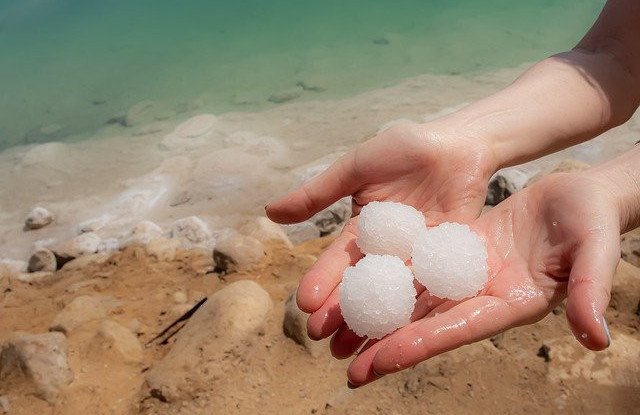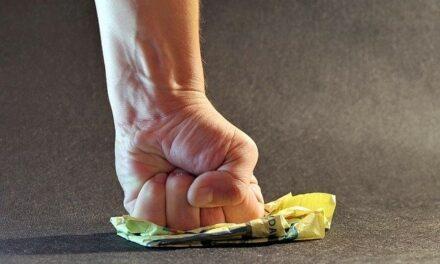People with diabetes have a higher risk of high blood pressure which can result in stroke, heart and kidney diseases. So, it is important for patients to manage their blood pressure to prevent it from going up. And, one of the ways to do that is by watching the quantity of our sodium intake. Sea salt and dead sea salt both have sodium, but which one is best for diabetes and high blood pressure?
Sodium is a vital mineral our body needs to balance the fluid in our body and control blood pressure. It is also needed for the proper functioning of the nerves and muscles.
Sea salt is a good source of sodium. A lot of people opt for sea salt in place of table salt because they believed that since it is unrefined, it is healthier. But the truth is that It contains almost the same amount of sodium chloride as the common table salt but with other 82 minerals in trace quantity which are beneficial to the body.
Sodium is an essential nutrient, but the quantity you consume has a direct effect on your blood pressure.
Dead sea salt is another type of sea salt, used for therapeutic purpose, it has a lower quantity of sodium and high quantity of other minerals which can help to improve the conditions of a patient with diabetes and high blood pressure.
When Managing diabetes and high blood pressure cutting down your salt intake does not mean your food has to be bland or tasteless. For example, you can use a salt substitute that uses potassium and magnesium in place of sodium. You can also use more natural spices like thyme, ginger, cayenne peppers, oregano, nutmeg etc.
To help to address the main question of this guide the differences between Sea Salt vs Dead Sea Salt, and their effects on Diabetes and Hypertension, let’s identify each salt type first.
What is Sea Salt?
Sea salt, also known as bay salt, are salt obtained by evaporating salty seawater or ocean water. Unlike our common table salt that is refined using different processing like bleaching, iodizing and diluting, sea salt is untreated, pure, natural and darker than the table salt.
The difference when using sea salt instead of table salt for cooking is that the sea salt has other minerals aside from sodium chloride, but these minerals are in trace quantity! And no iodine! And our body really needs iodine for the proper functioning of the thyroid gland.
Sea salt contains a little amount of natural iodine but as not as the iodine content in the common table salt. Sea salt depending on the source and method of extraction varies in grain size from fine grain to coarse, irregular shapes and flakes. It also varies in colors, flavor and amount of sodium chloride and trace elements.
Tip: Have you heard about Chinen Salt? We covered that earlier.
What is Dead Sea Salt?
Dead Sea salt refers to salt obtained from the Dead Sea.
Don’t be misled, the dead sea is not actually an ocean or a sea but a salt lake that lies in the Jordan rift valley with River Jordan as the main tributary.
The dead sea itself is also a type of sea salt, but its composition differs significantly from other types of sea salt.
Dead sea salt ls not used as a food seasoning, but for beauty and therapeutic purposes. This is because the minerals found in Dead Sea salts which are magnesium, calcium, iodine, zinc, bromide, potassium and sulfur are similar to minerals found in the skin cells and are beneficial for anti-aging, keeping the skin healthy and well-nourished.

Tip: Struggle with stress and poor sleep? A Himalayan salt inhaler could help you.
Differences of Dead Sea Salt from Common Sea Salt?
The Dead Sea salt is extracted from the dead sea while sea salt is obtained from evaporating salty seawater or ocean water from any part of the world.
Dead sea salt is used for therapeutic and skincare purposes, while common sea salt is used in cuisine and cooking purpose.
The dead sea salt has only about 12 to 18 % sodium chloride. It is rich in mineral compounds, having about 21 minerals with magnesium, calcium, potassium, chlorides, sulfur and bromides in higher concentration. The low sodium chloride content makes the dead sea salt not to be an acceptable cooking salt. The rich mineral content makes it to taste bitter.
Meanwhile, the sea salt has about 97 % sodium chloride while the remaining percentage contains an 82 trace element. Since it has almost the same percentage of sodium chloride as the table salt, it is used for cooking and the additional trace element though it may be in little quantity but is an added bonus.
Sea salt is mainly used for culinary purposes whereas Dead Sea salt are used for therapeutic purposes
Benefits of Dead Sea Salt
Dead Sea salts have been claimed and believed to treat the following health conditions.
Rheumatism
Soaking in or bathing with dead sea salt water believed to help you treat Rheumatic Diseases such as psoriatic arthritis, osteoarthritis and rheumatoid arthritis. In this case, the minerals from the dead sea salt are absorbed through your skin, and believed to enhance your blood circulation.
Skin conditions
Soaking in Dead Sea salt can be effective in relieving common skin conditions like acne, eczema and psoriasis because of the high concentration of magnesium in the salt, which helps in hydrating the skin and easing inflammation.
Inflammation
The high concentration of bromide and magnesium in the dead sea salt helps in easing inflammation. This helps to relieve allergic reactions of the skin.
Dandruff
Washing your hair with it makes the hair soft and free from dandruff. The sulfur in it accelerates hair growth.
Anti-aging
Use for exfoliating to get rid of dead skin cells and cleansing the skin pores, which helps in the regeneration of the skin. It also softens the skin and keeps it moisturized, which in return reduce the appearance of wrinkles, thereby slowing down ageing.
Cellulitis
It helps to get rid of toxins from the skin and promotes blood circulation. This helps to reduce the appearance of cellulite.
Skin tone
It helps to firm up skin tissues and strengthens it.
Ease pain
It helps eliminate body pains and ease muscle tension. This helps the body be more relaxed, thereby reducing stress and anxiety.
Swelling
It helps to reduce swelling and edema.

Tip: Here are the health benefits of Himalayan Salt bricks, walls, spas and caves.
Which Salt is Best for Diabetes? Why?
Dead sea salt is well-known for its ability to boost the circulation of blood, especially at the lower extreme.
Other bath salts make you sweat, which is not good for diabetics. Dead sea salt has unique healing properties because of the unique chemical structure found only in the waters of the dead sea. These unique properties promote circulation and moisturize the skin.
Also, soaking in dead seawater for about 20 minutes can facilitate a drop in blood sugar levels which can improve diabetes. This is according to research conducted by Israeli researchers. It is also claimed that the potassium in it helps to reduce water retention in the body, which will help with diabetes-related edema.
Which Salt is Best for High Blood Pressure? Why?
Sodium chloride is the main mineral in sea salt.
The sodium ion is the electrolyte that regulates and balances the fluid in our body, sends electrical signals to the nervous system and balances the blood pressure. Lack or insufficient it in our body can result in Hyponatremia which causes dehydration, confusion, muscle spasm, seizure and even death.
Excess sodium can cause your body to retain water, and when you eat too much of it, your body can retain too much water which can increase your blood pressure and putting more strain on your heart, kidney, arteries and brain. This can result in stroke, kidney problem, heart attack and dementia.
Sea salt contains almost the same amount of sodium chloride as our common table salt. So, using too much of it for cooking is not different from using too much table salt.
American Heart Association (AHA) recommends that one should not consume more than 2,300 milligrams of salt daily. For a person with high blood pressure reducing your salt intake to 1000 to 1500 milligrams daily will help to improve your blood pressure.
Dead sea salt in its basic form is not edible because it has a bitter taste due to the high amount of other minerals like magnesium and bromine in it. But it has a lower amount of sodium. Using it for therapeutic purpose can help to reduce high blood pressure and some of its triggers.
Dead sea salt helps to promote the circulation of blood, ease body pain and muscular tension which induces relaxation resulting in good night sleep. The potassium in dead sea salt also helps to reduce water retention in the body.

Caution
- Do not shave before using sea salt as this may sting a little bit
- Bathing or soaking in sea salt can make existing wounds or cuts to sting.
- Avoid contacts with the eyes.
- Consult a doctor if you are pregnant and if you have hypertension.
- Also consult your doctor before using Dead Sea Salts as treatments for Atopic Dermatitis Psoriasis, Eczema, Arthritis and any other skin conditions.
- Drink water after soaking in a salt bath to prevent dehydration.
Are There Better Salt Substitutes?
Salt substitutes are alternative table salts that have low-sodium that are meant to be used to minimize the risk of developing and managing high blood pressure and other cardiovascular diseases linked to high sodium intake, while still giving similar taste like salt.
Salt substitutes have salty tastes that is as a result of other compounds aside from sodium chloride. They use potassium and magnesium to substitute the sodium thereby reducing the daily intake of sodium and the consequent health effects of high sodium intake.
The most commonly used salt substitute is potassium chloride with the chemical formula KCl. It has almost the same level of toxicity as sodium chloride for a healthy person.
When used in high quantity, potassium chloride may have a bitter aftertaste.
Other salt substitutes that include magnesium and potassium as their primary substance are Carnallite, Kainit, langbeinite, sylwinite, polyhalite and kieserite.
Other salt substitutes are seaweed granules, natural spices like cayenne pepper, ginger, thyme, basil, nutmeg, cinnamon, paprika, mint etc. the also add taste to our meals.

Warning!
Salt substitutes with potassium are not recommended for diabetics or people with heart diseases or kidney diseases because their body may not be able to excrete the potassium which may result to excess potassium in the body known as hyperkalemia.
Hyperkalemia can cause muscle pain and weakness, and irregular heartbeat, which may lead to cardiac arrest and death.
Conclusion
Although sea salts are natural, unrefined salt and with many elements in trace amount which our body needs and without additives, but it still has a high quantity of sodium. So the key to using sea salt is to use it in moderation.
For a diabetic patient, excess intake of sea salt cannot raise blood sugar levels, but it can increase your blood pressure, and since excess sodium can cause water retention, it can worsen your edema.
Also, for people with hypertension, cutting down your salt Intake (not eliminating) one way to help manage your blood pressure. Dead sea salt, on the other hand, is lower in sodium with other minerals in larger quantity which has a lot of beauty and health benefits. It can be used to manage diabetics and high blood pressure-related symptoms, but since it is not edible, salt substitutes can be used for cooking to minimize sodium intake.







